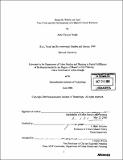Route 66, where are you? : four cities and the development of a shared cultural resource
Author(s)
Dodge, Anne Clayton
DownloadFull printable version (54.55Mb)
Alternative title
Route sixty-six, where are you? : four cities and the development of a shared cultural resource
Other Contributors
Massachusetts Institute of Technology. Dept. of Urban Studies and Planning.
Advisor
J. Mark Schuster.
Terms of use
Metadata
Show full item recordAbstract
Although small towns, rural areas, state organizations, and federal programs are all pursuing the redevelopment of the Route 66 corridor, this paper focuses on how four urban communities currently are engaging with this cultural resource: Albuquerque, New Mexico; Tulsa, Oklahoma; Rancho Cucamonga, California; and Flagstaff, Arizona. More specifically, the paper answers two central questions; have urban places along the Route 66 corridor engaged in the preservation, development, and interpretation of the route, and if so, how and why have those forms of engagement differed from one another. Four case study chapters describe how engagement has taken different forms in different cities depending upon the city's overall economic and political context, the city's other redevelopment efforts, and the degree to which the city's built fabric has survived the last twenty to thirty years of the corridor's economic decline. Each chapter concludes with site-specific recommendations for each city. After examining several local contexts for corridor redevelopment, the paper analyzes Route 66 as a national cultural resource and recommends strategies for local and interstate development and interpretation. (cont.) Currently, Route 66 preservationists, advocates, and planners view states and cities as the route's primary "units of preservation", since these are the units in which preservation activity most often occurs. An alternative approach encourages Route 66 advocates to focus on regional and cultural themes as units for corridor redevelopment. This approach would emphasize the corridor's connectivity by treating Route 66 as an interconnected network of places that interpret a common history. For the Route 66 corridor to reach its fullest potential both on the local and national level, it must be developed as a continuous place, in which each of its components contributes to the overall corridor's success.
Description
Thesis (M.C.P.)--Massachusetts Institute of Technology, Dept. of Urban Studies and Planning, 2006. Includes bibliographical references (p. 112-117).
Date issued
2006Department
Massachusetts Institute of Technology. Department of Urban Studies and PlanningPublisher
Massachusetts Institute of Technology
Keywords
Urban Studies and Planning.